Comprehensive Guide to Managing Financial Resources and Reporting
VerifiedAdded on 2023/06/10
|12
|1810
|221
Homework Assignment
AI Summary
This assignment provides comprehensive answers related to managing financial resources, covering key areas such as financial reporting, forecasting methods, and budget planning. It delves into the statutory requirements for budget preparation, issues related to budget expenses, and techniques for assessing costs and returns from assets and liabilities. Furthermore, the assignment discusses management responsibilities for reporting and staff consultation, methods for analyzing financial reports, and the information required to assess the effects of financial decisions. Comparative and trend information for future budgets, negotiation stages, resource allocation, and monitoring expenditure are also examined. The document also highlights methods for improving budget audit mechanisms, analyzing financial risks, and creating financial risk management reports. It concludes with action plans for addressing budget deviations and monitoring the financial system, providing a thorough overview of financial resource management principles and practices, and is available for students on Desklib, a platform offering a wide range of study tools and solved assignments.
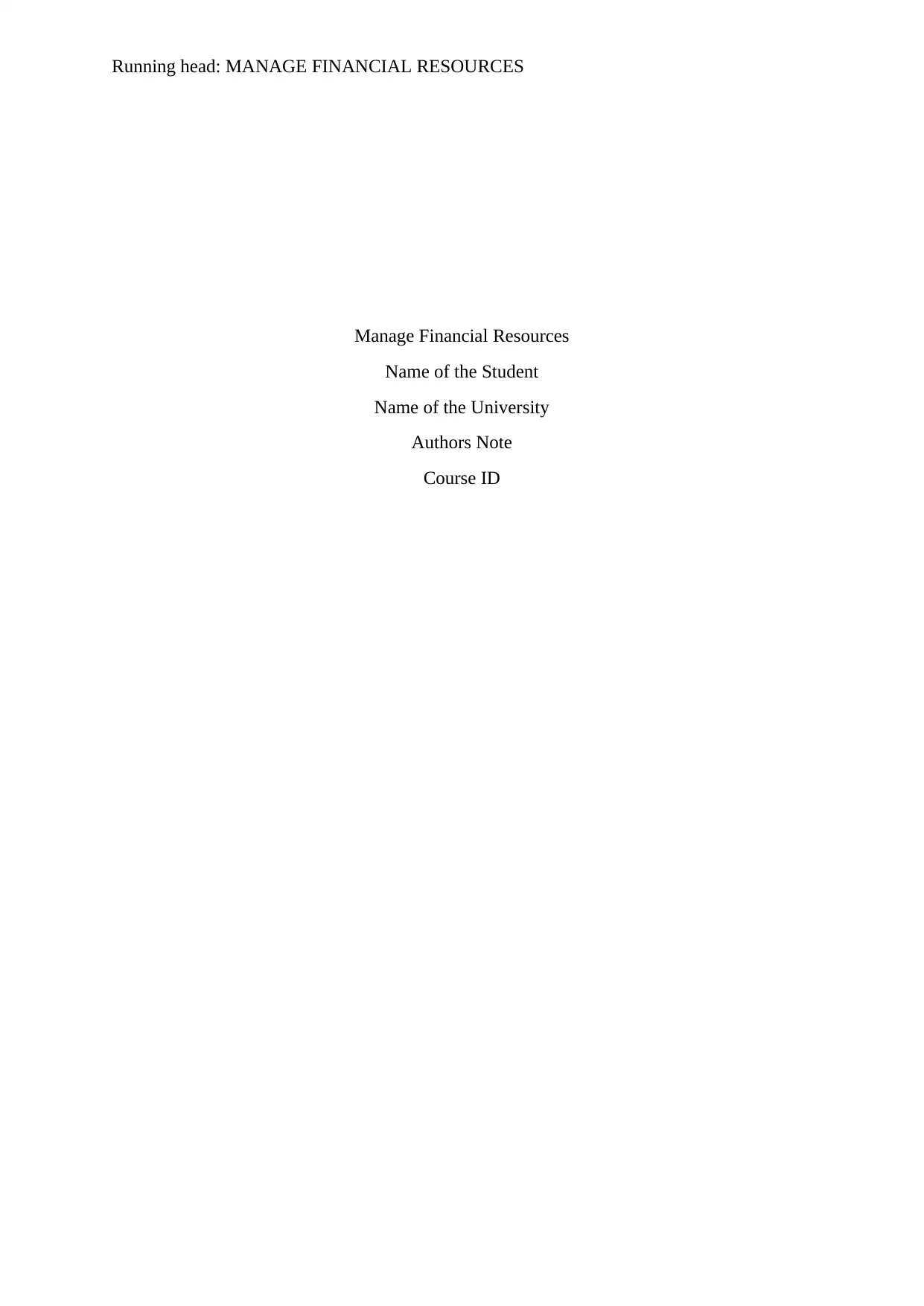
Running head: MANAGE FINANCIAL RESOURCES
Manage Financial Resources
Name of the Student
Name of the University
Authors Note
Course ID
Manage Financial Resources
Name of the Student
Name of the University
Authors Note
Course ID
Paraphrase This Document
Need a fresh take? Get an instant paraphrase of this document with our AI Paraphraser
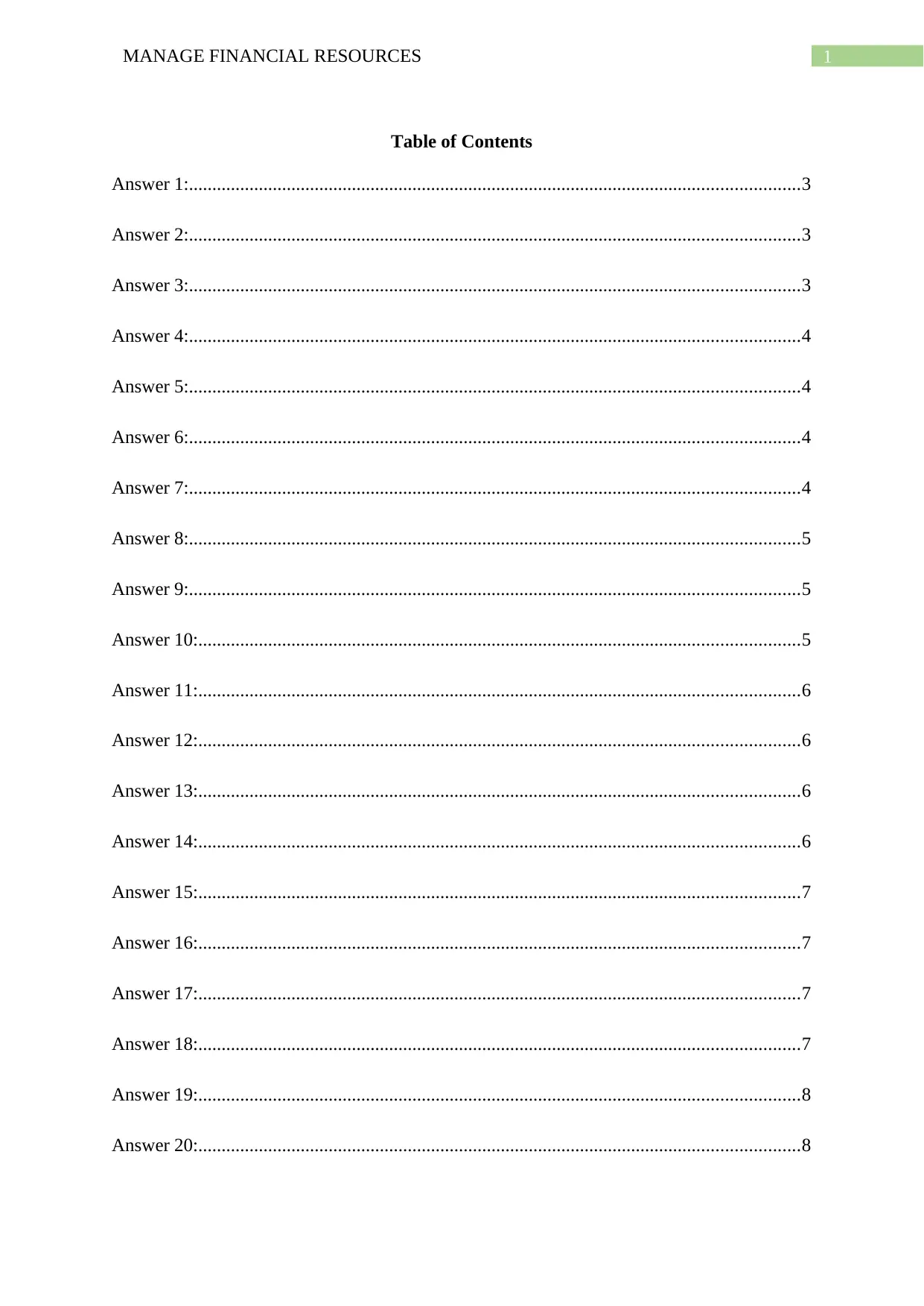
1MANAGE FINANCIAL RESOURCES
Table of Contents
Answer 1:...................................................................................................................................3
Answer 2:...................................................................................................................................3
Answer 3:...................................................................................................................................3
Answer 4:...................................................................................................................................4
Answer 5:...................................................................................................................................4
Answer 6:...................................................................................................................................4
Answer 7:...................................................................................................................................4
Answer 8:...................................................................................................................................5
Answer 9:...................................................................................................................................5
Answer 10:.................................................................................................................................5
Answer 11:.................................................................................................................................6
Answer 12:.................................................................................................................................6
Answer 13:.................................................................................................................................6
Answer 14:.................................................................................................................................6
Answer 15:.................................................................................................................................7
Answer 16:.................................................................................................................................7
Answer 17:.................................................................................................................................7
Answer 18:.................................................................................................................................7
Answer 19:.................................................................................................................................8
Answer 20:.................................................................................................................................8
Table of Contents
Answer 1:...................................................................................................................................3
Answer 2:...................................................................................................................................3
Answer 3:...................................................................................................................................3
Answer 4:...................................................................................................................................4
Answer 5:...................................................................................................................................4
Answer 6:...................................................................................................................................4
Answer 7:...................................................................................................................................4
Answer 8:...................................................................................................................................5
Answer 9:...................................................................................................................................5
Answer 10:.................................................................................................................................5
Answer 11:.................................................................................................................................6
Answer 12:.................................................................................................................................6
Answer 13:.................................................................................................................................6
Answer 14:.................................................................................................................................6
Answer 15:.................................................................................................................................7
Answer 16:.................................................................................................................................7
Answer 17:.................................................................................................................................7
Answer 18:.................................................................................................................................7
Answer 19:.................................................................................................................................8
Answer 20:.................................................................................................................................8
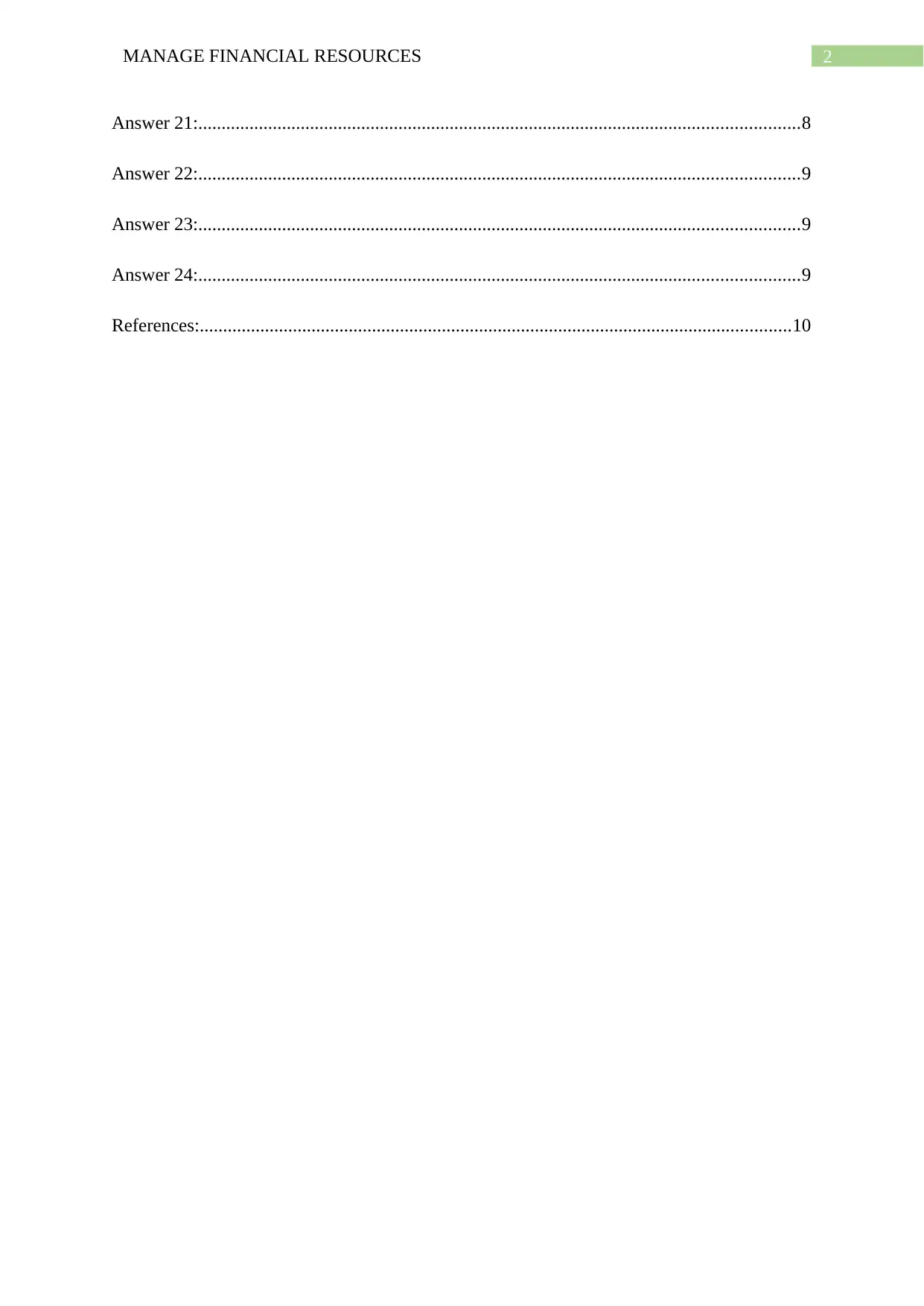
2MANAGE FINANCIAL RESOURCES
Answer 21:.................................................................................................................................8
Answer 22:.................................................................................................................................9
Answer 23:.................................................................................................................................9
Answer 24:.................................................................................................................................9
References:...............................................................................................................................10
Answer 21:.................................................................................................................................8
Answer 22:.................................................................................................................................9
Answer 23:.................................................................................................................................9
Answer 24:.................................................................................................................................9
References:...............................................................................................................................10
⊘ This is a preview!⊘
Do you want full access?
Subscribe today to unlock all pages.

Trusted by 1+ million students worldwide
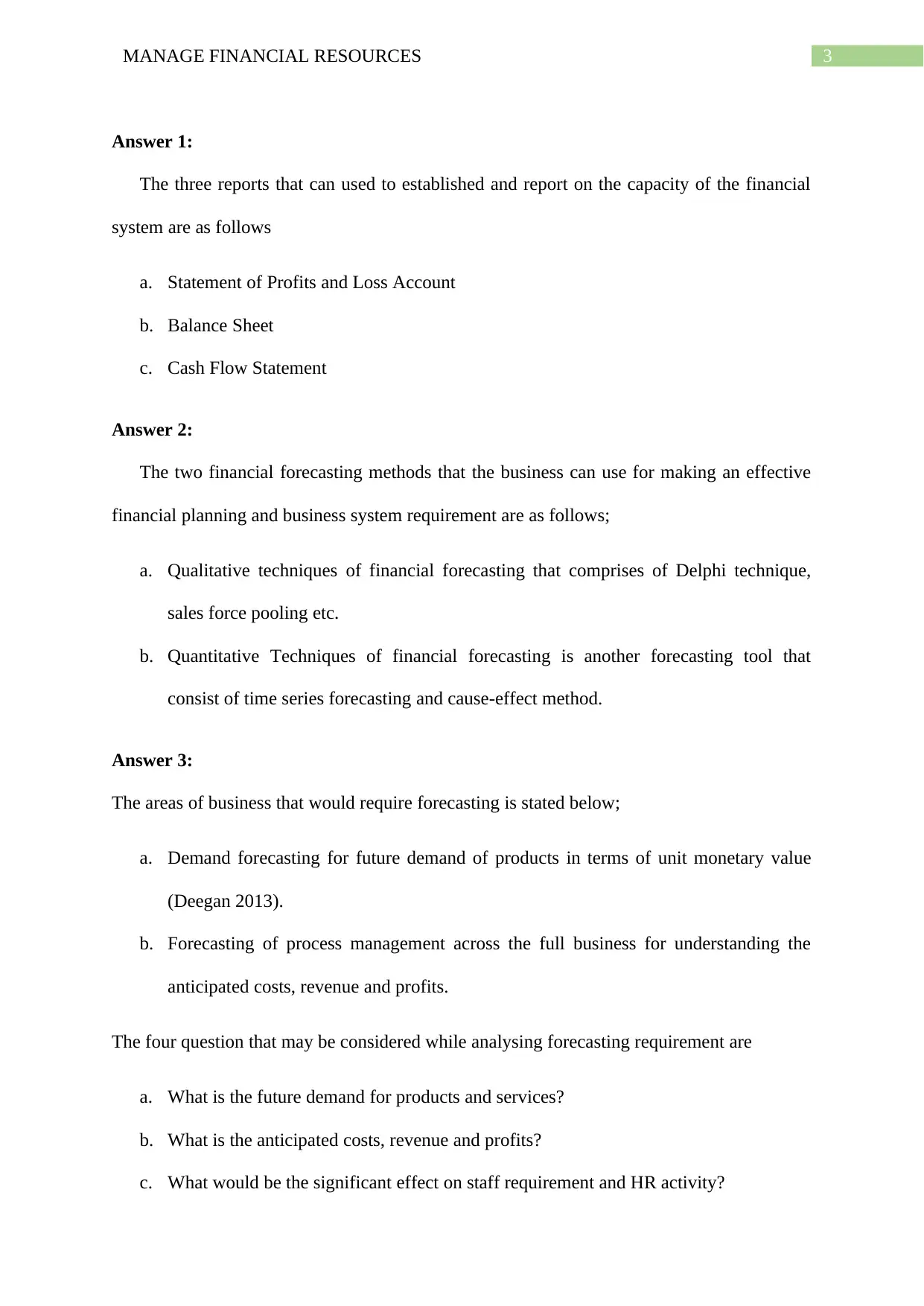
3MANAGE FINANCIAL RESOURCES
Answer 1:
The three reports that can used to established and report on the capacity of the financial
system are as follows
a. Statement of Profits and Loss Account
b. Balance Sheet
c. Cash Flow Statement
Answer 2:
The two financial forecasting methods that the business can use for making an effective
financial planning and business system requirement are as follows;
a. Qualitative techniques of financial forecasting that comprises of Delphi technique,
sales force pooling etc.
b. Quantitative Techniques of financial forecasting is another forecasting tool that
consist of time series forecasting and cause-effect method.
Answer 3:
The areas of business that would require forecasting is stated below;
a. Demand forecasting for future demand of products in terms of unit monetary value
(Deegan 2013).
b. Forecasting of process management across the full business for understanding the
anticipated costs, revenue and profits.
The four question that may be considered while analysing forecasting requirement are
a. What is the future demand for products and services?
b. What is the anticipated costs, revenue and profits?
c. What would be the significant effect on staff requirement and HR activity?
Answer 1:
The three reports that can used to established and report on the capacity of the financial
system are as follows
a. Statement of Profits and Loss Account
b. Balance Sheet
c. Cash Flow Statement
Answer 2:
The two financial forecasting methods that the business can use for making an effective
financial planning and business system requirement are as follows;
a. Qualitative techniques of financial forecasting that comprises of Delphi technique,
sales force pooling etc.
b. Quantitative Techniques of financial forecasting is another forecasting tool that
consist of time series forecasting and cause-effect method.
Answer 3:
The areas of business that would require forecasting is stated below;
a. Demand forecasting for future demand of products in terms of unit monetary value
(Deegan 2013).
b. Forecasting of process management across the full business for understanding the
anticipated costs, revenue and profits.
The four question that may be considered while analysing forecasting requirement are
a. What is the future demand for products and services?
b. What is the anticipated costs, revenue and profits?
c. What would be the significant effect on staff requirement and HR activity?
Paraphrase This Document
Need a fresh take? Get an instant paraphrase of this document with our AI Paraphraser
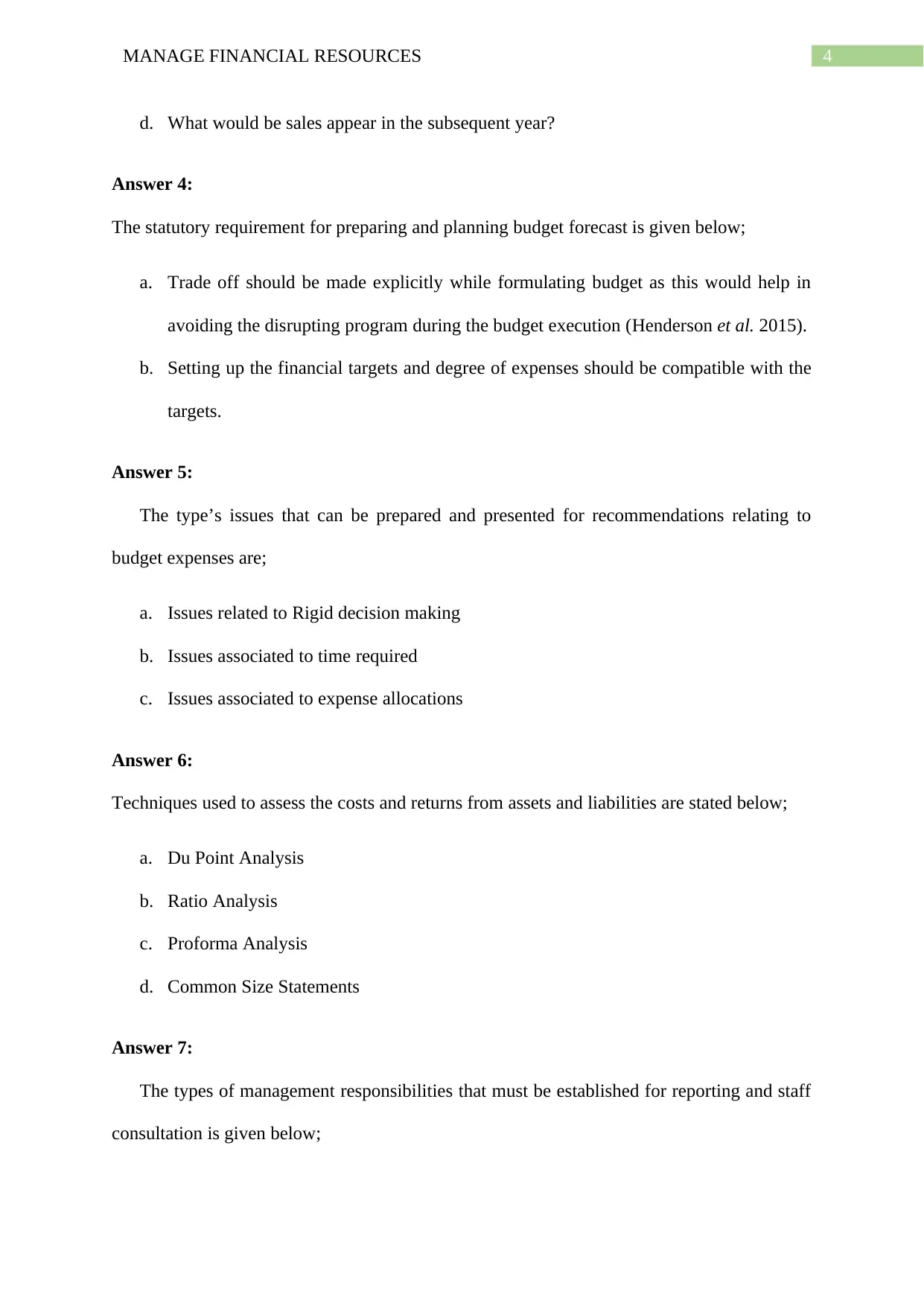
4MANAGE FINANCIAL RESOURCES
d. What would be sales appear in the subsequent year?
Answer 4:
The statutory requirement for preparing and planning budget forecast is given below;
a. Trade off should be made explicitly while formulating budget as this would help in
avoiding the disrupting program during the budget execution (Henderson et al. 2015).
b. Setting up the financial targets and degree of expenses should be compatible with the
targets.
Answer 5:
The type’s issues that can be prepared and presented for recommendations relating to
budget expenses are;
a. Issues related to Rigid decision making
b. Issues associated to time required
c. Issues associated to expense allocations
Answer 6:
Techniques used to assess the costs and returns from assets and liabilities are stated below;
a. Du Point Analysis
b. Ratio Analysis
c. Proforma Analysis
d. Common Size Statements
Answer 7:
The types of management responsibilities that must be established for reporting and staff
consultation is given below;
d. What would be sales appear in the subsequent year?
Answer 4:
The statutory requirement for preparing and planning budget forecast is given below;
a. Trade off should be made explicitly while formulating budget as this would help in
avoiding the disrupting program during the budget execution (Henderson et al. 2015).
b. Setting up the financial targets and degree of expenses should be compatible with the
targets.
Answer 5:
The type’s issues that can be prepared and presented for recommendations relating to
budget expenses are;
a. Issues related to Rigid decision making
b. Issues associated to time required
c. Issues associated to expense allocations
Answer 6:
Techniques used to assess the costs and returns from assets and liabilities are stated below;
a. Du Point Analysis
b. Ratio Analysis
c. Proforma Analysis
d. Common Size Statements
Answer 7:
The types of management responsibilities that must be established for reporting and staff
consultation is given below;
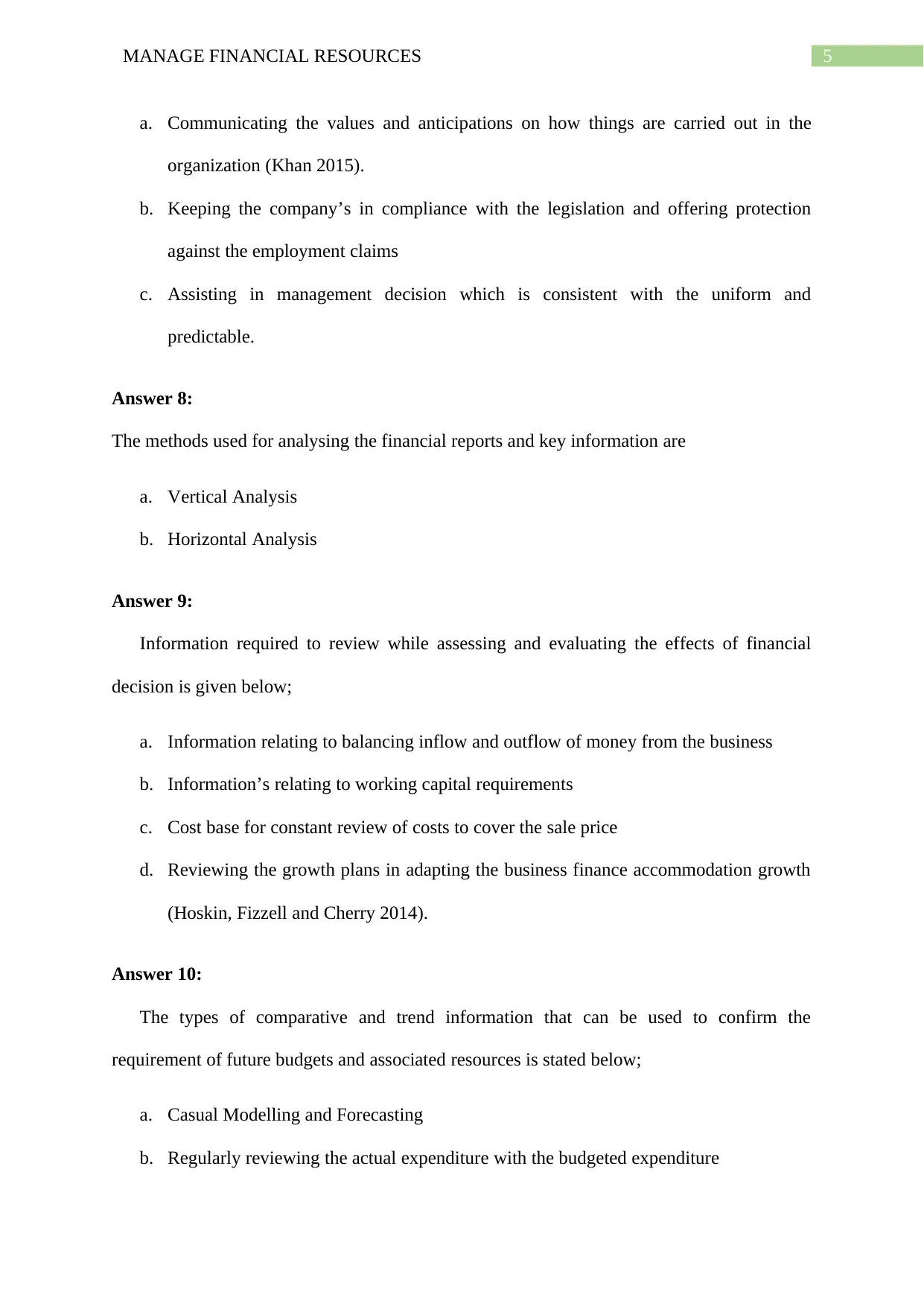
5MANAGE FINANCIAL RESOURCES
a. Communicating the values and anticipations on how things are carried out in the
organization (Khan 2015).
b. Keeping the company’s in compliance with the legislation and offering protection
against the employment claims
c. Assisting in management decision which is consistent with the uniform and
predictable.
Answer 8:
The methods used for analysing the financial reports and key information are
a. Vertical Analysis
b. Horizontal Analysis
Answer 9:
Information required to review while assessing and evaluating the effects of financial
decision is given below;
a. Information relating to balancing inflow and outflow of money from the business
b. Information’s relating to working capital requirements
c. Cost base for constant review of costs to cover the sale price
d. Reviewing the growth plans in adapting the business finance accommodation growth
(Hoskin, Fizzell and Cherry 2014).
Answer 10:
The types of comparative and trend information that can be used to confirm the
requirement of future budgets and associated resources is stated below;
a. Casual Modelling and Forecasting
b. Regularly reviewing the actual expenditure with the budgeted expenditure
a. Communicating the values and anticipations on how things are carried out in the
organization (Khan 2015).
b. Keeping the company’s in compliance with the legislation and offering protection
against the employment claims
c. Assisting in management decision which is consistent with the uniform and
predictable.
Answer 8:
The methods used for analysing the financial reports and key information are
a. Vertical Analysis
b. Horizontal Analysis
Answer 9:
Information required to review while assessing and evaluating the effects of financial
decision is given below;
a. Information relating to balancing inflow and outflow of money from the business
b. Information’s relating to working capital requirements
c. Cost base for constant review of costs to cover the sale price
d. Reviewing the growth plans in adapting the business finance accommodation growth
(Hoskin, Fizzell and Cherry 2014).
Answer 10:
The types of comparative and trend information that can be used to confirm the
requirement of future budgets and associated resources is stated below;
a. Casual Modelling and Forecasting
b. Regularly reviewing the actual expenditure with the budgeted expenditure
⊘ This is a preview!⊘
Do you want full access?
Subscribe today to unlock all pages.

Trusted by 1+ million students worldwide
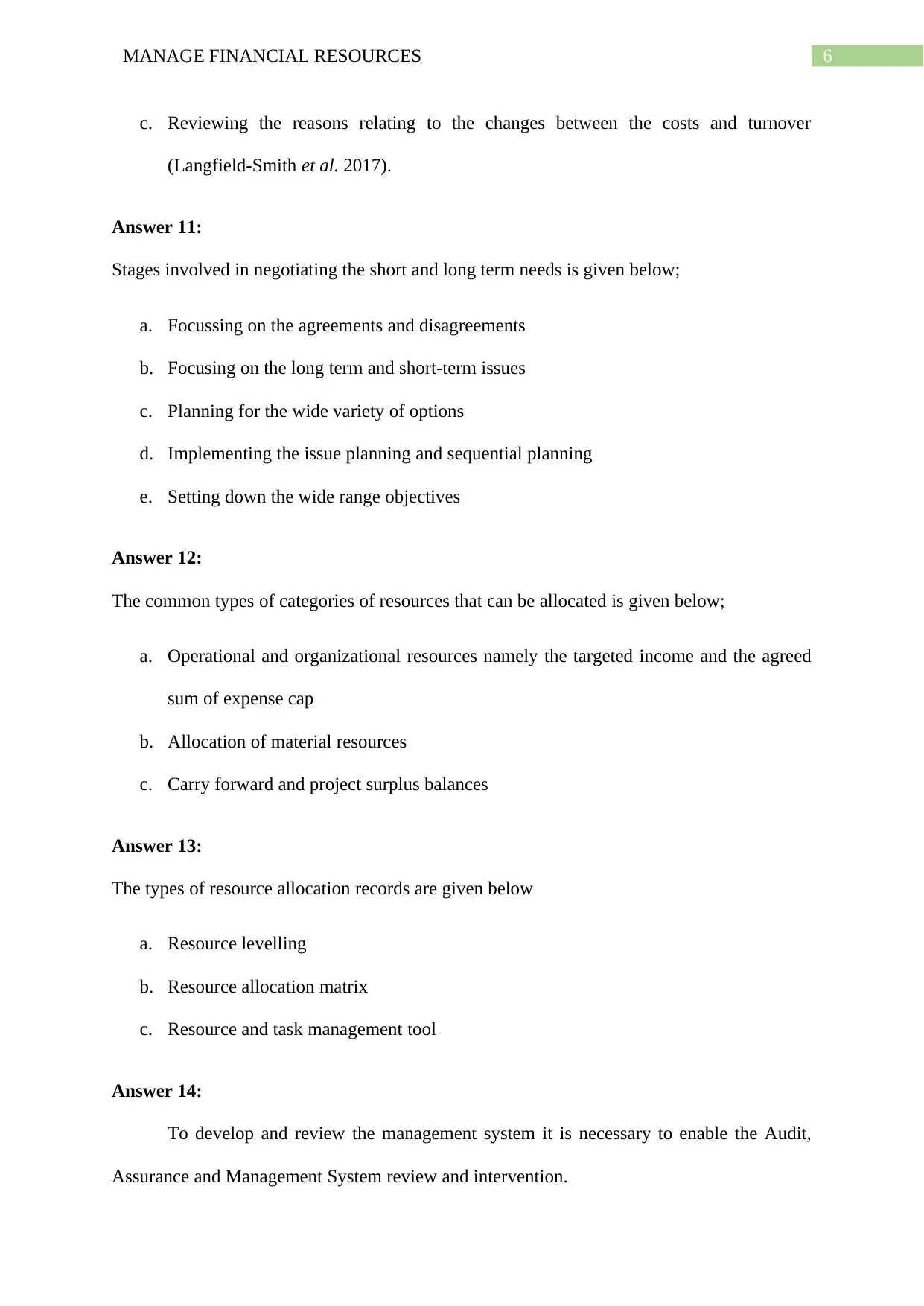
6MANAGE FINANCIAL RESOURCES
c. Reviewing the reasons relating to the changes between the costs and turnover
(Langfield-Smith et al. 2017).
Answer 11:
Stages involved in negotiating the short and long term needs is given below;
a. Focussing on the agreements and disagreements
b. Focusing on the long term and short-term issues
c. Planning for the wide variety of options
d. Implementing the issue planning and sequential planning
e. Setting down the wide range objectives
Answer 12:
The common types of categories of resources that can be allocated is given below;
a. Operational and organizational resources namely the targeted income and the agreed
sum of expense cap
b. Allocation of material resources
c. Carry forward and project surplus balances
Answer 13:
The types of resource allocation records are given below
a. Resource levelling
b. Resource allocation matrix
c. Resource and task management tool
Answer 14:
To develop and review the management system it is necessary to enable the Audit,
Assurance and Management System review and intervention.
c. Reviewing the reasons relating to the changes between the costs and turnover
(Langfield-Smith et al. 2017).
Answer 11:
Stages involved in negotiating the short and long term needs is given below;
a. Focussing on the agreements and disagreements
b. Focusing on the long term and short-term issues
c. Planning for the wide variety of options
d. Implementing the issue planning and sequential planning
e. Setting down the wide range objectives
Answer 12:
The common types of categories of resources that can be allocated is given below;
a. Operational and organizational resources namely the targeted income and the agreed
sum of expense cap
b. Allocation of material resources
c. Carry forward and project surplus balances
Answer 13:
The types of resource allocation records are given below
a. Resource levelling
b. Resource allocation matrix
c. Resource and task management tool
Answer 14:
To develop and review the management system it is necessary to enable the Audit,
Assurance and Management System review and intervention.
Paraphrase This Document
Need a fresh take? Get an instant paraphrase of this document with our AI Paraphraser
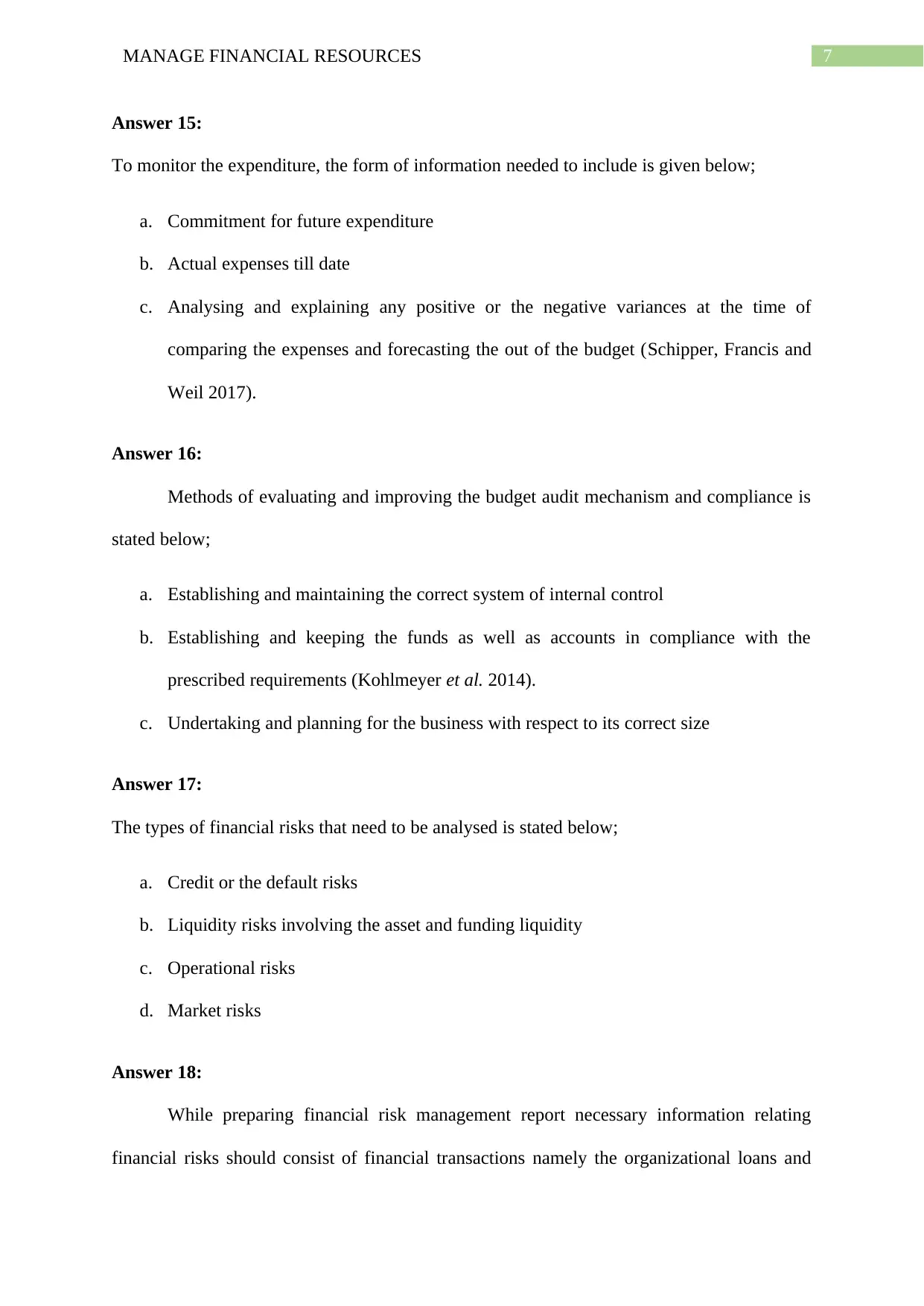
7MANAGE FINANCIAL RESOURCES
Answer 15:
To monitor the expenditure, the form of information needed to include is given below;
a. Commitment for future expenditure
b. Actual expenses till date
c. Analysing and explaining any positive or the negative variances at the time of
comparing the expenses and forecasting the out of the budget (Schipper, Francis and
Weil 2017).
Answer 16:
Methods of evaluating and improving the budget audit mechanism and compliance is
stated below;
a. Establishing and maintaining the correct system of internal control
b. Establishing and keeping the funds as well as accounts in compliance with the
prescribed requirements (Kohlmeyer et al. 2014).
c. Undertaking and planning for the business with respect to its correct size
Answer 17:
The types of financial risks that need to be analysed is stated below;
a. Credit or the default risks
b. Liquidity risks involving the asset and funding liquidity
c. Operational risks
d. Market risks
Answer 18:
While preparing financial risk management report necessary information relating
financial risks should consist of financial transactions namely the organizational loans and
Answer 15:
To monitor the expenditure, the form of information needed to include is given below;
a. Commitment for future expenditure
b. Actual expenses till date
c. Analysing and explaining any positive or the negative variances at the time of
comparing the expenses and forecasting the out of the budget (Schipper, Francis and
Weil 2017).
Answer 16:
Methods of evaluating and improving the budget audit mechanism and compliance is
stated below;
a. Establishing and maintaining the correct system of internal control
b. Establishing and keeping the funds as well as accounts in compliance with the
prescribed requirements (Kohlmeyer et al. 2014).
c. Undertaking and planning for the business with respect to its correct size
Answer 17:
The types of financial risks that need to be analysed is stated below;
a. Credit or the default risks
b. Liquidity risks involving the asset and funding liquidity
c. Operational risks
d. Market risks
Answer 18:
While preparing financial risk management report necessary information relating
financial risks should consist of financial transactions namely the organizational loans and
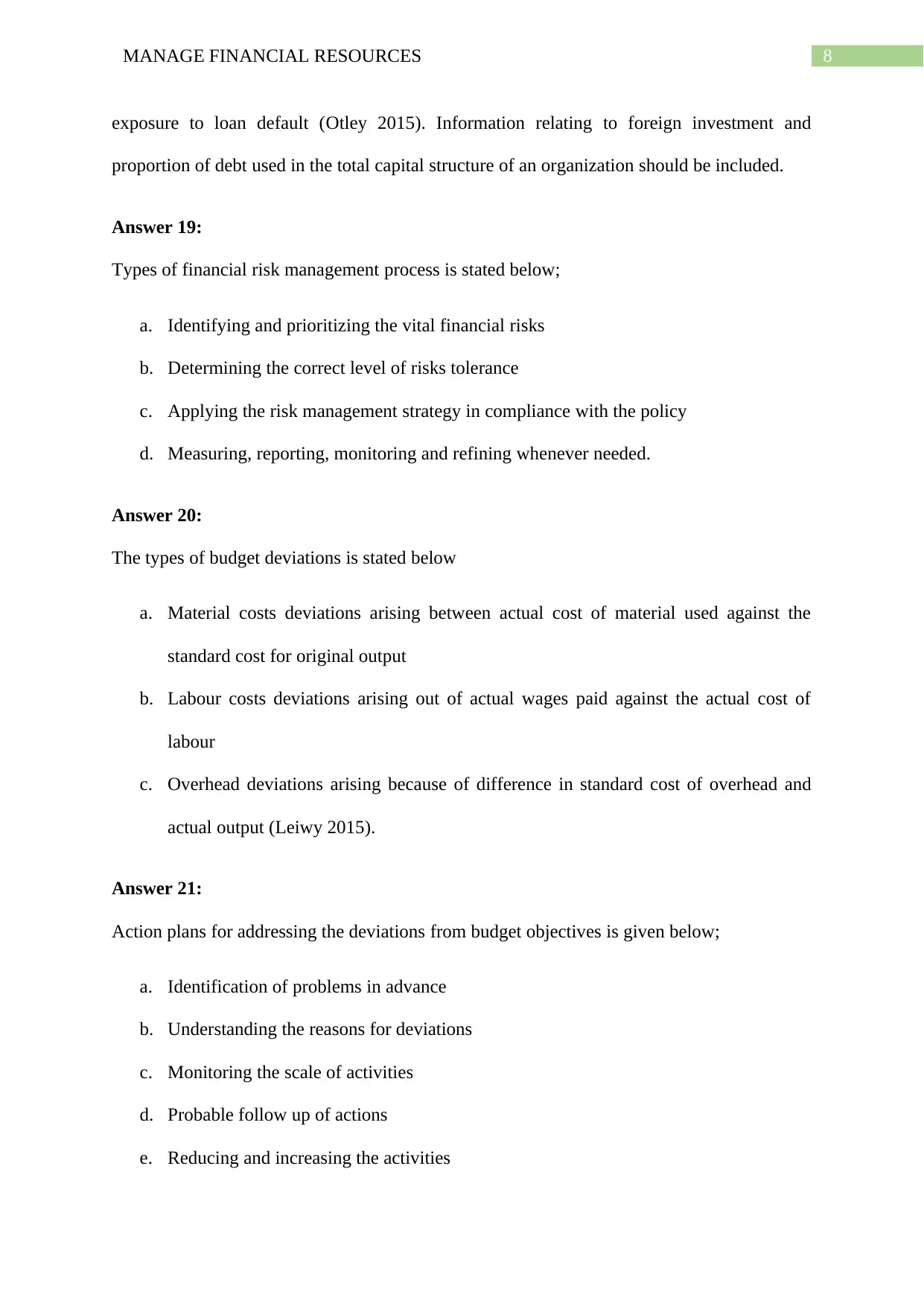
8MANAGE FINANCIAL RESOURCES
exposure to loan default (Otley 2015). Information relating to foreign investment and
proportion of debt used in the total capital structure of an organization should be included.
Answer 19:
Types of financial risk management process is stated below;
a. Identifying and prioritizing the vital financial risks
b. Determining the correct level of risks tolerance
c. Applying the risk management strategy in compliance with the policy
d. Measuring, reporting, monitoring and refining whenever needed.
Answer 20:
The types of budget deviations is stated below
a. Material costs deviations arising between actual cost of material used against the
standard cost for original output
b. Labour costs deviations arising out of actual wages paid against the actual cost of
labour
c. Overhead deviations arising because of difference in standard cost of overhead and
actual output (Leiwy 2015).
Answer 21:
Action plans for addressing the deviations from budget objectives is given below;
a. Identification of problems in advance
b. Understanding the reasons for deviations
c. Monitoring the scale of activities
d. Probable follow up of actions
e. Reducing and increasing the activities
exposure to loan default (Otley 2015). Information relating to foreign investment and
proportion of debt used in the total capital structure of an organization should be included.
Answer 19:
Types of financial risk management process is stated below;
a. Identifying and prioritizing the vital financial risks
b. Determining the correct level of risks tolerance
c. Applying the risk management strategy in compliance with the policy
d. Measuring, reporting, monitoring and refining whenever needed.
Answer 20:
The types of budget deviations is stated below
a. Material costs deviations arising between actual cost of material used against the
standard cost for original output
b. Labour costs deviations arising out of actual wages paid against the actual cost of
labour
c. Overhead deviations arising because of difference in standard cost of overhead and
actual output (Leiwy 2015).
Answer 21:
Action plans for addressing the deviations from budget objectives is given below;
a. Identification of problems in advance
b. Understanding the reasons for deviations
c. Monitoring the scale of activities
d. Probable follow up of actions
e. Reducing and increasing the activities
⊘ This is a preview!⊘
Do you want full access?
Subscribe today to unlock all pages.

Trusted by 1+ million students worldwide
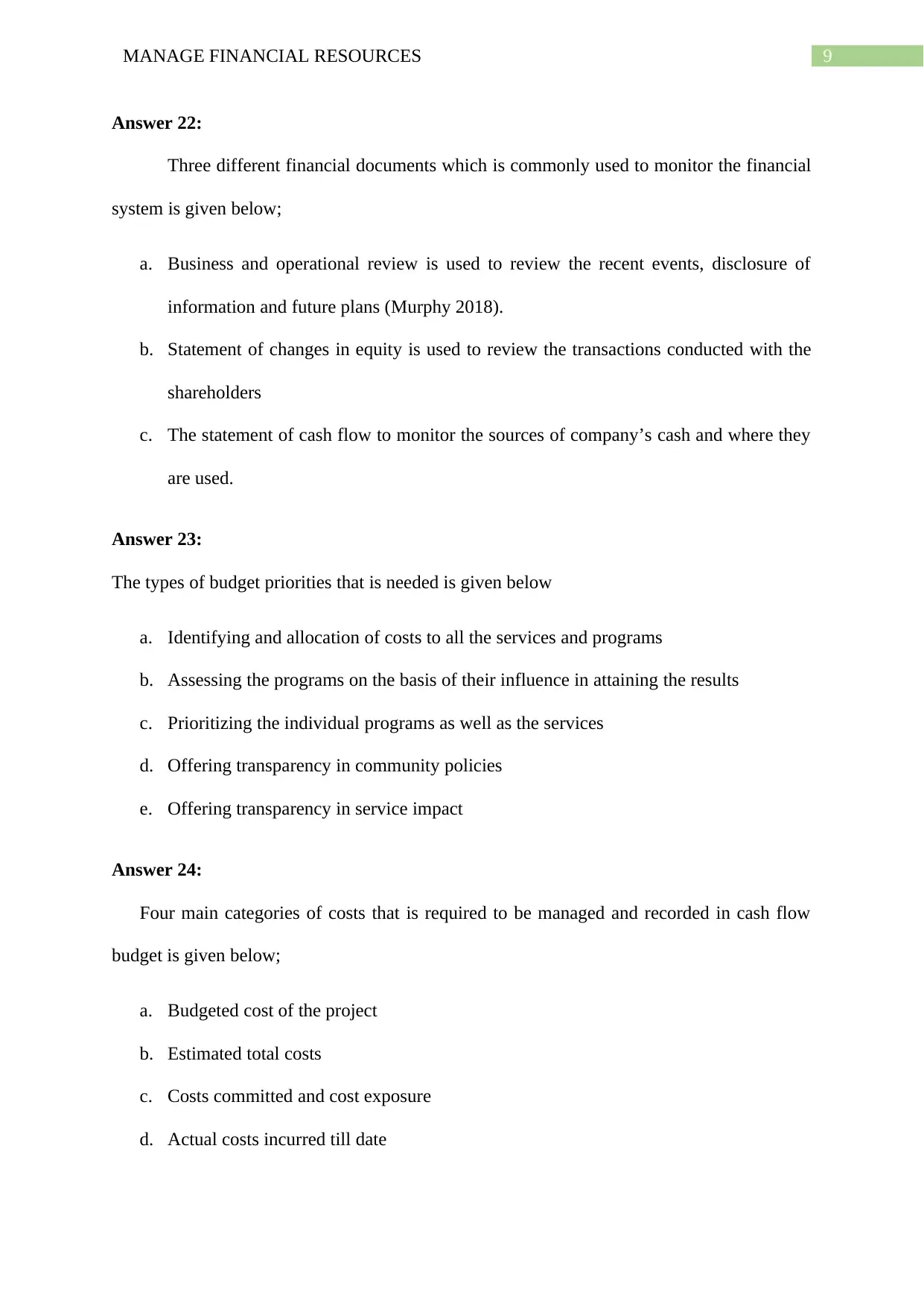
9MANAGE FINANCIAL RESOURCES
Answer 22:
Three different financial documents which is commonly used to monitor the financial
system is given below;
a. Business and operational review is used to review the recent events, disclosure of
information and future plans (Murphy 2018).
b. Statement of changes in equity is used to review the transactions conducted with the
shareholders
c. The statement of cash flow to monitor the sources of company’s cash and where they
are used.
Answer 23:
The types of budget priorities that is needed is given below
a. Identifying and allocation of costs to all the services and programs
b. Assessing the programs on the basis of their influence in attaining the results
c. Prioritizing the individual programs as well as the services
d. Offering transparency in community policies
e. Offering transparency in service impact
Answer 24:
Four main categories of costs that is required to be managed and recorded in cash flow
budget is given below;
a. Budgeted cost of the project
b. Estimated total costs
c. Costs committed and cost exposure
d. Actual costs incurred till date
Answer 22:
Three different financial documents which is commonly used to monitor the financial
system is given below;
a. Business and operational review is used to review the recent events, disclosure of
information and future plans (Murphy 2018).
b. Statement of changes in equity is used to review the transactions conducted with the
shareholders
c. The statement of cash flow to monitor the sources of company’s cash and where they
are used.
Answer 23:
The types of budget priorities that is needed is given below
a. Identifying and allocation of costs to all the services and programs
b. Assessing the programs on the basis of their influence in attaining the results
c. Prioritizing the individual programs as well as the services
d. Offering transparency in community policies
e. Offering transparency in service impact
Answer 24:
Four main categories of costs that is required to be managed and recorded in cash flow
budget is given below;
a. Budgeted cost of the project
b. Estimated total costs
c. Costs committed and cost exposure
d. Actual costs incurred till date
Paraphrase This Document
Need a fresh take? Get an instant paraphrase of this document with our AI Paraphraser
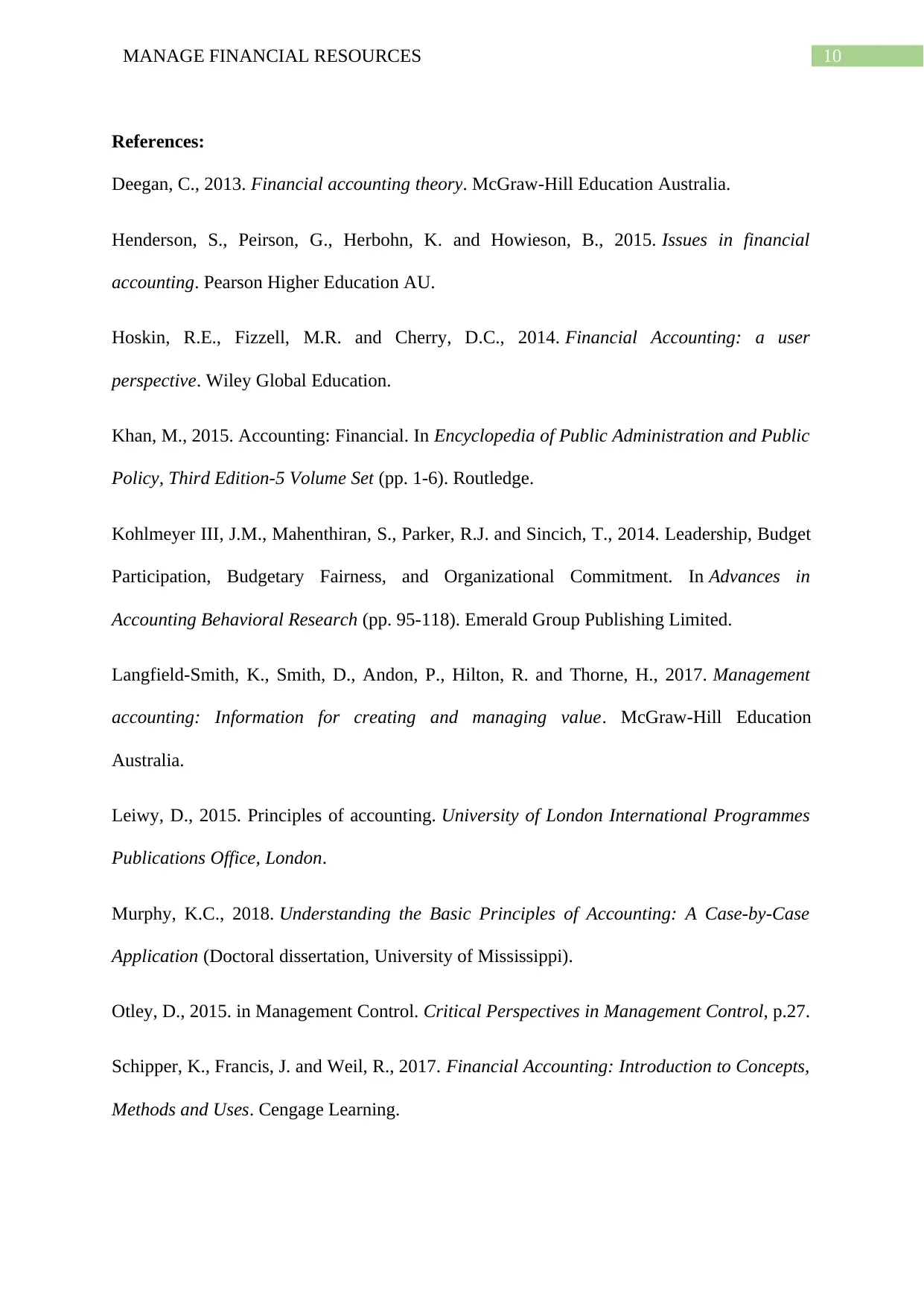
10MANAGE FINANCIAL RESOURCES
References:
Deegan, C., 2013. Financial accounting theory. McGraw-Hill Education Australia.
Henderson, S., Peirson, G., Herbohn, K. and Howieson, B., 2015. Issues in financial
accounting. Pearson Higher Education AU.
Hoskin, R.E., Fizzell, M.R. and Cherry, D.C., 2014. Financial Accounting: a user
perspective. Wiley Global Education.
Khan, M., 2015. Accounting: Financial. In Encyclopedia of Public Administration and Public
Policy, Third Edition-5 Volume Set (pp. 1-6). Routledge.
Kohlmeyer III, J.M., Mahenthiran, S., Parker, R.J. and Sincich, T., 2014. Leadership, Budget
Participation, Budgetary Fairness, and Organizational Commitment. In Advances in
Accounting Behavioral Research (pp. 95-118). Emerald Group Publishing Limited.
Langfield-Smith, K., Smith, D., Andon, P., Hilton, R. and Thorne, H., 2017. Management
accounting: Information for creating and managing value. McGraw-Hill Education
Australia.
Leiwy, D., 2015. Principles of accounting. University of London International Programmes
Publications Office, London.
Murphy, K.C., 2018. Understanding the Basic Principles of Accounting: A Case-by-Case
Application (Doctoral dissertation, University of Mississippi).
Otley, D., 2015. in Management Control. Critical Perspectives in Management Control, p.27.
Schipper, K., Francis, J. and Weil, R., 2017. Financial Accounting: Introduction to Concepts,
Methods and Uses. Cengage Learning.
References:
Deegan, C., 2013. Financial accounting theory. McGraw-Hill Education Australia.
Henderson, S., Peirson, G., Herbohn, K. and Howieson, B., 2015. Issues in financial
accounting. Pearson Higher Education AU.
Hoskin, R.E., Fizzell, M.R. and Cherry, D.C., 2014. Financial Accounting: a user
perspective. Wiley Global Education.
Khan, M., 2015. Accounting: Financial. In Encyclopedia of Public Administration and Public
Policy, Third Edition-5 Volume Set (pp. 1-6). Routledge.
Kohlmeyer III, J.M., Mahenthiran, S., Parker, R.J. and Sincich, T., 2014. Leadership, Budget
Participation, Budgetary Fairness, and Organizational Commitment. In Advances in
Accounting Behavioral Research (pp. 95-118). Emerald Group Publishing Limited.
Langfield-Smith, K., Smith, D., Andon, P., Hilton, R. and Thorne, H., 2017. Management
accounting: Information for creating and managing value. McGraw-Hill Education
Australia.
Leiwy, D., 2015. Principles of accounting. University of London International Programmes
Publications Office, London.
Murphy, K.C., 2018. Understanding the Basic Principles of Accounting: A Case-by-Case
Application (Doctoral dissertation, University of Mississippi).
Otley, D., 2015. in Management Control. Critical Perspectives in Management Control, p.27.
Schipper, K., Francis, J. and Weil, R., 2017. Financial Accounting: Introduction to Concepts,
Methods and Uses. Cengage Learning.
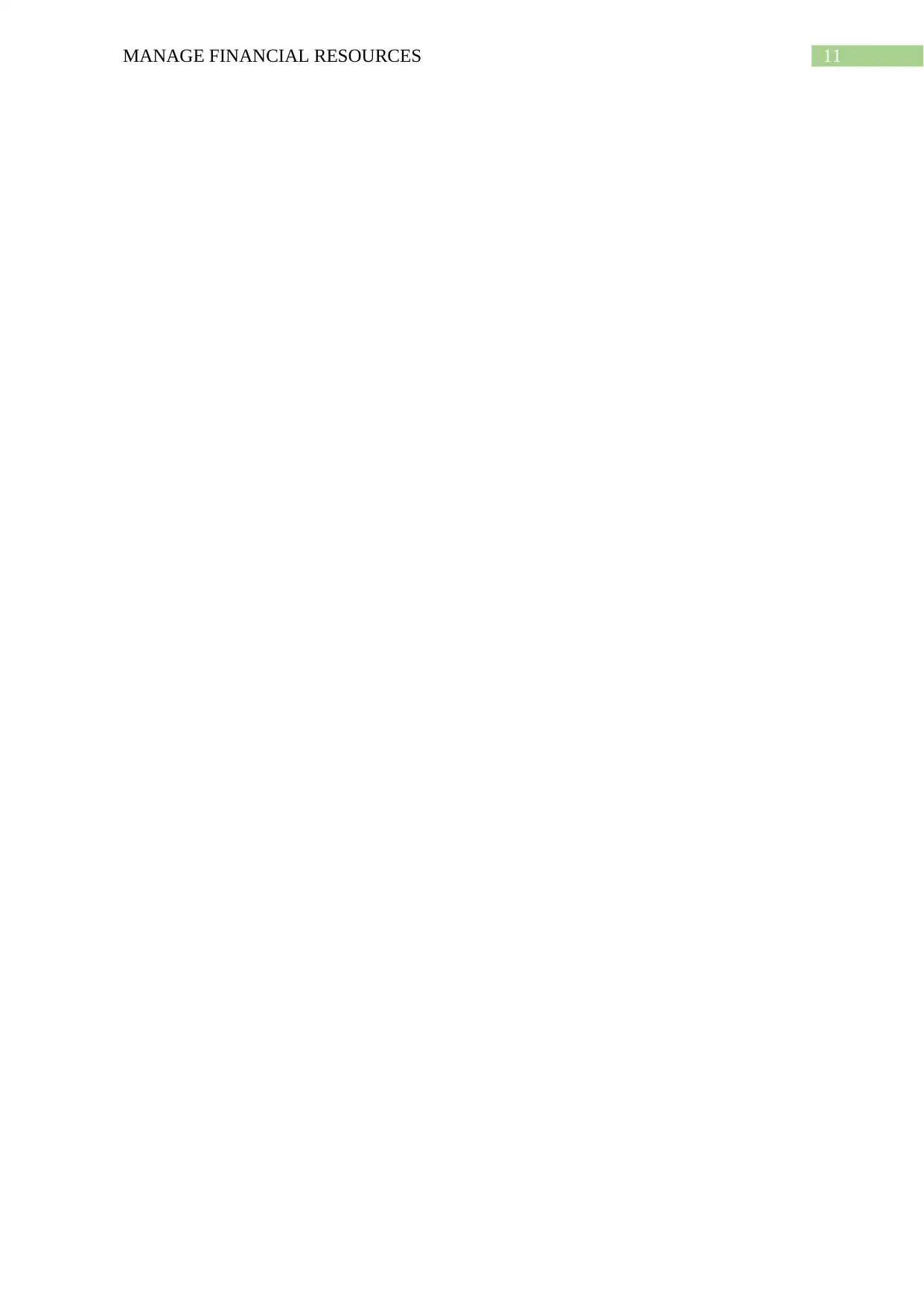
11MANAGE FINANCIAL RESOURCES
⊘ This is a preview!⊘
Do you want full access?
Subscribe today to unlock all pages.

Trusted by 1+ million students worldwide
1 out of 12
Related Documents
Your All-in-One AI-Powered Toolkit for Academic Success.
+13062052269
info@desklib.com
Available 24*7 on WhatsApp / Email
![[object Object]](/_next/static/media/star-bottom.7253800d.svg)
Unlock your academic potential
Copyright © 2020–2025 A2Z Services. All Rights Reserved. Developed and managed by ZUCOL.





